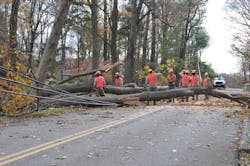Can Milford’s Microgrid Keep the Power on During a Hurricane?
When Hurricane Sandy struck on October 29, 2012, Milford lost power for seven days, explains Chris Saley, Milford’s director of Public Works. “They didn’t have refrigeration, their pumps didn’t work, and they didn’t have water or sewers. People didn’t have cell phones that charged,” he says.
Then, after hurricanes Harvey, Irma and Sandy battered the coastal city of Milford, Ct. and its 52,000 citizens, the town decided to act. Its government developed a plan to build a microgrid to strengthen the town’s infrastructure and protect it against natural occurrences and other disasters. The goals are to enhance safety, improve the city’s resiliency and save money on power.
To build the microgrid, Milford issued requests for proposals and hired Schneider Electric, a global energy management and automation firm that has built over 60 microgrids nationwide including ones in Fairfield, Ct. and Montgomery County, Md., notes Mark Feasel, Schneider Electric’s vice president of Utility Segment, Smartgrid and Microgrid, who is based in Findlay, Ohio.
Milford financed the project by obtaining a $2.9 million grant from the Connecticut Department of Energy and Environmental Protection (DEEP). It will cost an additional $1.8 million, which was borrowed via a leasing company, Saley explains, but the grant made the project viable and cost-effective.
The engineering has been completed, and while the city is still coordinating with its electric company, the project is slated to begin later in 2018 and should take about 27 months to finish, says Saley.
THREE GOALS
Milford established three goals in developing the microgrid: resiliency, sustainability and cost, Feasel explains. Strengthening its infrastructure would make Milford more resilient and lessen any damage from “storms, cybersecurity and vandalism,” he says.
Saley underscores that point saying, “When power goes off all around us, we’ll still be operating. People can come and the city can still do its business.”
The city selected five sites to connect on the microgrid: a middle school, the senior center, River Park Elderly Apartments, the Parsons Government Center and City Hall. The five sites will be physically connected by building trenches underground and running wires to link them. Unlike in major metropolises, in smaller cities such as Milford, the poles, transformers and substations are above ground and moving them below ground is often extremely costly.
Each site offers a strategic capability. Milford opted to protect the most vulnerable citizens, which are often the sick and elderly. Three of the sites (the school, senior center and government office) function as shelters. By selecting a school, it afforded Milford the opportunity to use it as an evacuation site and turn the cafeteria into a temporary medical center and tap the cafeteria to serve food. City Hall keeps the government functioning, provides the major load and is the nexus where fire, police and ambulances would be dispatched.
“When the main grid goes down, it can be difficult to get emergency power routed to all the loads that require it. If we can physically connect these building together to form a microgrid, we can make the most of existing generation while having new generation that can be routed anywhere there is a need,” Feasel observes.
“The microgrid,” Feasel says, “is more sophisticated in nature, a little more resilient, and draws from multiple sources of generation, and has energy storage that is battery-powered.”
Saley notes that no heat is lost in the microgrid. “You’re using the heat produced from the energy to heat the building, it lowers our electricity rates, which saves money,” he adds.
SAVING MONEY
Furthermore, the microgrid is more sustainable than the main grid, which relies on a mix of coal and natural gas. It is 30 percent greener than the grid, and Milford could opt to add solar after it’s completed. The grid costs about 16 cents a kilowatt hour for energy but it costs about 13 cents for the microgrid, about a 20 percent savings. “They’re going to save $1 million to $2 million over a 20-year period,” Feasel asserts.
The microgrid is also more efficient. It relies on a combination of power and heat (CHP). “It’s less carbon intensive generation. By using battery-powered energy, we can flatten the load, take out peaks,” he says. If Milford opts to install solar panels, its costs will stabilize since it won’t have to rely on the variable prices of natural gas and oil.
Feasel describes this new power source as an “n plus one.” N stands for the amount of power a municipality uses and plus one described the back-up source.
The microgrid also enables Milford to tap Virtual Net Metering Credits, which enables energy to be run at lower kilowatts and offset loads.
LONG-TERM BENEFITS
Feasel expects that Milford will reap a variety of long-term benefits from installing the microgrid. “They’re going to pay less for energy, and protect their citizens when the power is going out, and be greener doing it,” he says. Think about what happens when a destructive hurricane strikes a city. “The traffic lights go out, ambulance can’t get to places, and the food gets spoiled. It can save lives,” he states.
Saley explains that the microgrid keeps Milford humming even when disasters, hurricanes or ice storms, strike. “We can run the business of the city under all circumstances. It saves money through efficiencies. And we’ll make sure people know if there’s a major event, there’s a place they can come to charge their phone or get a hot meal.”
About the Author
Gary M Stern
Gary M. Stern has written for the New York Times, Fortune.com, CNN/Money, and has lived his whole life in New York State.
